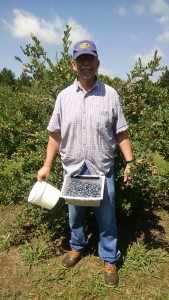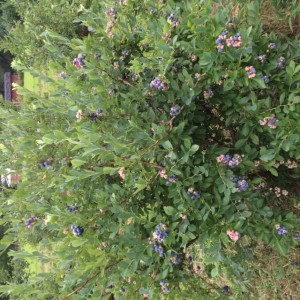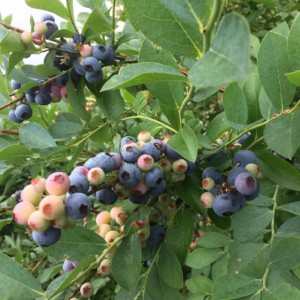Blueberries are gorgeous with their bell-shaped white flowers, dusty-blue fruit and reddish fall foliage. They are probably the easiest of all fruit to start growing. Blueberries are well-adapted North American natives and have virtually no disease or pest problems as long as they are planted in a suitable location. The only pests commonly encountered are birds. So, bird netting is a must near harvest time. Just be vigilant and watch for snakes getting tangled in the netting.
Blueberries will produce berries the first year from one-gallon or three-gallon size plants. Some experts recommend pulling the berries off for the first three or four years to increase the plant’s vigor. But, I disagree with that procedure. Why not eat berries as soon as possible?
Plant blueberries from containers in the late spring or in the early fall. Pick a sunny or partial shade location that has a light well-drained soil with a pH of 4.0 to 5.5. Get a soil test done through your local garden center or county extension agent. You may need to adjust the pH with a soil acidifier such as Aluminum sulfate, peat moss or rotted sawdust. If you are doing a multiple planting space the plants 4’ to 6’ apart. Use a closer spacing of 3’ apart if you are making an edible hedge. Plant the container plants to the same depth as the soil line was in the nursery container. Keep the young plants continuously moist before planting and for the first few days after planting. Try to keep the top foot of soil moist by watering weekly after the initial few days. Add a 6” layer of mulch such as ground pine bark, composted leaves or pine straw around the new plants to maintain soil moisture and prevent weeds. Fertilize with an acid-loving plant fertilizer with a low nitrogen analysis such as an azalea fertilizer when the plants are blooming.
After planting, pruning should not be necessary the first 2 to 3 years. After 3 years, start pruning out some of the older canes yearly to renew the plant’s energy and increase fruit production. It is best to prune blueberries in late winter or early spring at the end of dormancy. Also, staking or cages are not necessary for these sturdy shrubs.
Blueberries will produce a crop with just one self-pollinating cultivar but it is best to have at least two cultivars for cross-pollination. This will ensure that you will have twice as many berries per plant versus just planting one cultivar. Also, by planting multiple varieties you can extend your harvest season from June to mid-September. Try planting an early season variety, a midseason variety and a late season variety to extend your harvest time.
When harvesting blueberries, you should look for the dark blue berries that have turned from green and reddish purple to dark blue in each cluster. The area around the stem (pedicel) is the last to ripen. So, check that each berry is ripe all the way around.
Whole clusters of berries should not be pulled off but instead individual ripe berries should be gingerly rolled off between your thumb and index finger. This will decrease the amount of unripe berries being accidentally harvested. Take care to check underneath each leaf and branch for hiding ripe berries. If you have more than 4 or 5 plants to pick, purchase a harvesting basket with a strap you can wear around your waist or neck to simplify picking.
The Rabbiteye varieties (Vaccinium ashei) such as ‘Tifblue’ and ‘Climax’ produce best in Zones 7 and 8. Southern Highbush hybrids (V. corymbosum hybrids) such as ‘Cape Fear’ and ‘Ozarkblue’ perform best in southern California and Florida. The Northern Highbush types (V. corymbosum) such as ‘Blueray’ and ‘Elliott’ grow best in the Northeast, Great Lakes region and the Northwest. The Half-high hybrids (V. corymbosum crossed with V. angustifolium) such as ‘Northland’ and ‘St. Cloud’ do well in regions where it is very cold like Minnesota. Lowbush varieties (V. angustifolium) such as ‘Tophat’ and ‘Burgundy’ grow best in the Northeastern region of the United States.



